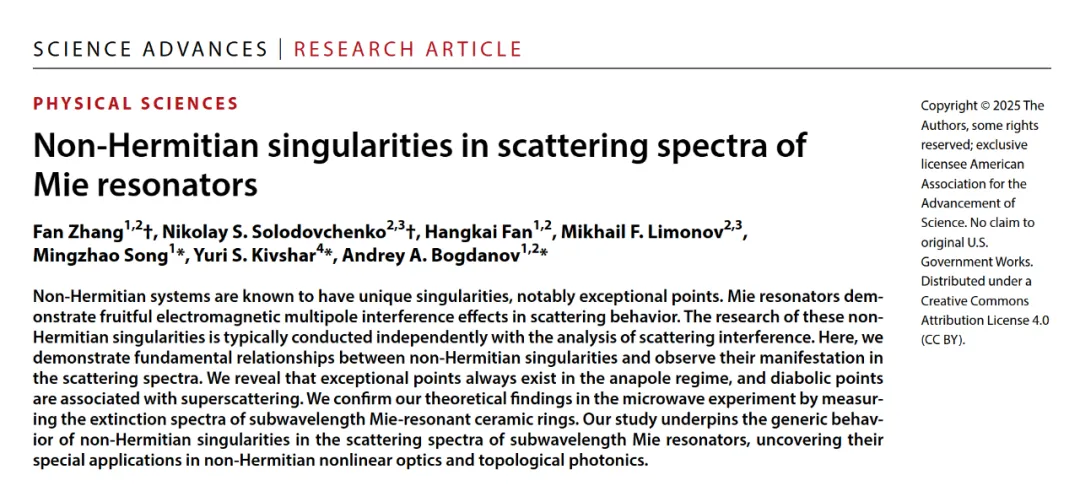
Recently, the International Joint Research Center for Nanophotonics and Metamaterials (the Ultra-nano Center) of the School of Physics and Optoelectronic Engineering of our university, in collaboration with international teams such as the Saint Petersburg State University of Information Technologies, Mechanics and Optics (ITMO University) in Russia and the Australian National University, has made important progress in the field of non-Hermitian photonics and the regulation of Mie resonances. Through the precise design of the subwavelength dielectric resonator structure, the research team has experimentally revealed for the first time the dynamic conversion law between the non-Hermitian Exceptional Point (EP) in the scattering spectrum and the Hermitian degenerate point (DP) with super-scattering characteristics, providing a brand-new theoretical framework for the development of highly sensitive sensors, electromagnetic stealth technology, multi-physical field energy regulation technology, and nonlinear optical devices. The relevant results were published in the international top journal (Science Advances) on February 21 under the title "Non-Hermitian Singular Points in the Scattering Spectrum of Mie Resonators", and our university is the first corresponding unit of the paper.
Traditional research holds that the exceptional points in non-Hermitian systems rely on complex coupling structures to be realized. In this study, by regulating the geometric parameters of a single toroidal dielectric resonator, the scattering spectrum characteristics of EP and DP were directly observed in the microwave frequency band (Figure 1). The experimental data show that EP corresponds to the scattering Anapole State, while DP exhibits a super-scattering phenomenon with the superposition of multiple modes. This discovery deeply integrates non-Hermitian physics and Mie photonics, opening up a new dimension for the regulation of light-matter interactions.

Fig. 1: Schematic of the annular dielectric resonator and scattering spectra showing exceptional points (EPs) and diabolic points (DPs).
“Dynamic switching between EPs and DPs in annular resonators could enable reconfigurable electromagnetic stealth surfaces or subwavelength-scale energy transfer devices,” explained Professor Song Mingzhao, corresponding author of the study. The research leveraged HEU’s Supernano Center’s integrated platform for theoretical modeling, simulation, and experimental validation. Potential applications include wireless power systems for medical implants and advanced photonic energy harvesters.
Focusing on the theory of multi-physics metamaterials and the application of devices, the ultra-nano center has built an international joint innovation team to carry out basic and applied basic research in the fields of multi-physics energy enrichment and transmission, nano-optoelectronic energy devices, etc., and has achieved a series of innovative achievements. He has published more than 50 high-impact publications papers in top-tier journals such as Nature Electronics, Nature Photonics, Nature Materials, Nature Nanotechnology, Science Advances, Nature Communications, and Physical Review Letters, with HEU as the leading and corresponding institution.
Science Advances, a leading multidisciplinary journal under the Science family, boasts an impact factor of 11.7 and publishes cutting-edge research across natural sciences.
Link to the paper:
https://www.science.org/doi/10.1126/sciadv.adr9183